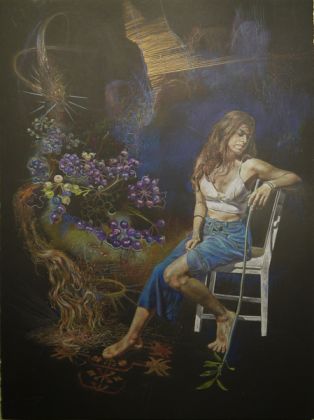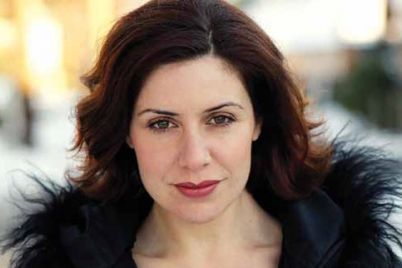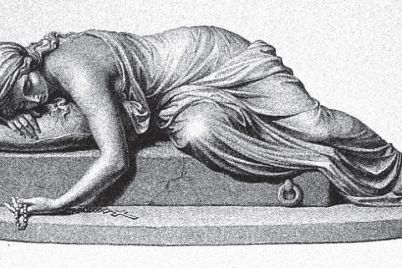The Artist
There is a mystery inside of every one of us. A place that we can’t begin to understand that exists independently of our thoughts and actions. A place that just is, that we may never encounter, never even know about. It is perhaps from this place that creativity flows – unrestrained, uncontrolled, limitless. While some people may fear this place – avoid it and pretend it doesn’t exist, squandering its every attempt to break free – others accept it, embrace it, maybe even tap into it for inspiration. Artist Giuseppe Di Leo is the latter type of person.

Left: Blending of Body and Soul (What is the meaning of this blending of body and soul?) (2018), 60 X 50 inches. Pencil, colour pencil, and pastel on Stonehenge paper. Right: Blending of Body and Soul II (How can I escape that which will share my resurrection) (2018), 60 X 50 inches. Pencil, colour pencil, and pastel on Stonehenge paper.
Di Leo describes drawing as “an existential portrait” and “a romantic endeavour; a form of escape that is transcendental in nature.” He speaks about the fact that once he revisits his drawings, he can’t quite remember the process of having made them. Drawing grants him a freedom that allows and perhaps encourages his curiosity, his desire to know more and learn more and explore more. A creator since childhood, his curious nature has constantly redefined the ways he has approached art-making throughout his life. Since his recent retirement from Dawson College, where he taught art classes for almost 35 years, his process has evolved. Whereas he used to approach new works with in-depth sketches and planned out compositions, he now tackles his drawing board head on: no notes, no practice runs, just confidence and trust borne from intuition and experience.
Born in Foggia, Italy, and emigrating to Montreal with his family as a child, Di Leo was always interested in art. He studied art at Concordia University (where he still teaches) under Guido Molinari, and took from him a sense of freedom that art can provide. Di Leo draws from a number of sources and points of inspiration that he combines fluidly and with intention. Religion, mythology, autobiography, classical references, art history… Never limiting himself to a single source, his works are rich and layered in meaning and resource.

Left: Sublimation after the Presentation (2016), 72 X 50 inches. Pencil and colour pencil on Stonehenge paper. Right: If I mortify him, I endanger myself (If I strike him down, I have nothing with which to obtain virtues) (2018), 60 X 50 inches. Pencil, colour pencil, and pastel on Stonehenge paper.
His recent exhibition Disegno at Galerie Deux Poissons in the Belgo Building in downtown Montreal (October 18-November 24, 2018) was curated by Ben Klein, and also included the work of landscape painter Susan Scott. In this joint exhibition, Di Leo presented six drawings. Each artwork is its own little universe, yet threads run through Di Leo’s body of work in recurring themes and objects. Each artwork, like a chapter in the life story of this artist, is connected to the next. Each artwork is unique and part of a larger narrative all at once.
The Artworks
Blending of Body and Soul (I and II), 2018
The sensitivity with which Di Leo approaches his work is palpable, not just because of the multitude of textures that he elicits through pencil, colour and tactile materials, but because of the strong sense of the real that his work evokes. Even though the compositions are made of many different elements – hair, hands holding on to each other, natural components swirling in a continuous motion – they come together to form a strange, but authentic existence. Perhaps this is because much of his work is based on lived experience. Di Leo’s mother was a seamstress. He describes watching her agile hands as she would make tiny stitches that would form a delicate array of identical snowflakes. He incorporates her craft in Blending of Body and Soul I, honouring her and the legacy of her work. The crocheted elements blend in with the pencil marks with unexpected harmony, just as the cascading hair becomes roots and vine tendrils with every curl and twist. Human connection, the plant world, the body and the soul are all one in this piece. From The Ladder of Divine Ascent, Di Leo narrows in on the question, “What is the meaning of this blending of body and soul?” Perhaps this series of drawings is his way of exploring the myriad of possibilities.
Sublimation After the Presentation, 2016
There is a religious undertone to most of Di Leo’s work, stemming from his Catholic upbringing. He takes his interpretations beyond the Church and into a greater existence, the universe. Many works take place in a spinning abyss, some outer corporeal space where the figures are both grounded and in limbo between a particular place and some unknown reality. Here, an art student creates multiple hands signifying multiple senses. She is lost in her artistic process, focused and entranced. There, a body – Di Leo’s – is a shell of his self, which is floating, perhaps encompassing this whole piece. The hands in the upper left corner (working hands, hands that know the earth, that create life and sustenance, and that belong to Di Leo’s neighbour, a gardener), imitate the hands of God, sending inspiration in the form of jelly fish down to the entranced art student. From Caravaggio’s Inspiration of St Matthew, 1602, an inspiration for the drawing, the angel’s instructions, have become creatures of the sea; the saint, an art student, hungry for creativity. The patterns on the student’s dress and on the tapestry covering her table continue the flow from this creative force, inspired by Oriental textiles, a topic about which Di Leo has long been passionate. The drapery on the left side adds a softness, a flowing and gentle quality, that breaks the intensity of the piece. It is a moment of inspiration, a glimpse into the mindset of the artist, the student, the believer.
If I Mortify Him, I Endanger Myself. (If I strike him down, I have nothing with which to obtain virtues….), 2018
Family is an important inspiration for Di Leo, as seen in Blending of Body and Soul. In this work, his father’s legs, aged, no longer hold him to the ground; his mother’s hands, reminiscent of their dexterity and ability to do the fine, delicate work of crocheting, are placed underneath. There is the slightest hint to her past work with a thin red thread that dangles down the center of the work, barely touching her hands, barely holding on to reality. It is a powerful piece infused with love and memory, feeling and thought surrounding the complexities of ageing – and of accompanying parents through this often difficult process. Di Leo approaches his drawing board with such tenderness and gratitude that it eases the soul and opens the heart to whatever is to come.

Sensation and Suspension (2015), 26 X 36 inches. Colour pencils on black Arches paper.
Sensation and Suspension, 2015
These last two works diverge slightly from the others. Smaller, on black paper, they are inspired by musical arrangements by Montreal composers. The first one, after Wings of Silence by composer John Rea, speaks to the rhythm of viola, clarinet, piano, violoncello and cornet that seem to defy time. If it were so simple, the universe would be like this: outside of time, where everything has its place – like a big jigsaw puzzle where pieces of the cosmos would fit into each other, geometrically, but also organically. This seems to be a suggestion in Di Leo’s work, where pieces are cut out of the background, and have their spot – just so – waiting for their return. However, were one to turn Di Leo’s drawing into a three-dimensional work, there might be other images on the back, and on each of the sides, lending to multiple interpretations and placements. It seems almost crystal-like, begging the question: what would happen if one of the puzzle pieces were to break its hold from gravity and float upward? What would be left in its wake? Luckily, the roots of the tree seem to hold everything together in this swirling and destabilizing scene. Nature has it under control. The jellyfish (a recurring theme in Di Leo’s work) are reminiscent of the inspiration being tossed down by the gardener/God-like figure in Sublimation After the Presentation – an ancient reminder of the complexity of existence on this earth.
Voix Éphémère, 2018

Voix Éphémère (2018), 36 X 26 inches. Colour pencils on black Arches paper.
Inspired by José Evangelista’s Cantus Sacri, a tripartite meditative a cappella chant that references biblical texts drawn from Songs of Solomon and The Book of Wisdom,this work unites all of the above explorations into a cohesive whole. This unity to Di Leo’s work is comforting: the essential oils from the spikenard plant – famously applied by Mary Magdalene to anoint the feet of Jesus – the locks of hair, the intermingling of plant life and animal life, the atmospheric dynamic of the cosmos, and within all of these elements, the human form – staunchly and meaningfully figurative. She sits within this hyper-terrestrial landscape, floating above the world, with the Oriental rug underfoot and the sea creatures descending from the limits of the dark surrounding, and she is at peace, holding a vine and looking downwards. She is as solid as the wooden chair that supports her, and as light as the rays piercing through the dark black ethereal mass that allows us to glimpse the twinkling purple undertones of the night sky. As we peak into the unknown, one thing is clear: it is beautiful.
Amanda Beattie has a Master’s degree in Art History. She teaches Art History at Dawson College and works in mediation and program development in the Education Department at DHC/ART Foundation for Contemporary Art in Montreal.



